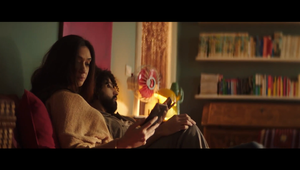Locaria’s Oksana Matchuk, director, creative adaptation and production, recently delved into as-yet-unrealised promises of AI in the realm of creative adaptation. Together with her team, Oksana has been testing multiple tools and, while none present the solutions that tick all the boxes, she’s confident that the current rate of progress means that the ‘unicorn’ tool will be available soon.
Today, LBB asks Oksana about AI’s wider applications in the creative industry, to learn where it’s succeeding, failing, and where the improvements are fast advancing. Much of the fear around AI replacing creativity is unfounded in Oksana’s eyes, especially as brands know that they get better results from content that’s dynamic and visually engaging which AI struggles with.
Below, Oksana outlines – realistically – the best case used for AI right now and in the near future; how it will become a tool for creative augmentation to be used by people, not a replacement; and why ethics is something the industry needs to think about more.
LBB> Adoption of AI and automation is accelerating across different industries. What’s your view on the current landscape?
Oksana> AI adoption is growing, but its impact varies across industries. While AI excels at simple, repetitive tasks, it still struggles with complex creative processes like video adaptation and creative transcreation (e.g. taglines). Many solutions are still in their infancy and require significant manual oversight.
LBB> Do you see a gap between the promise of AI and the actual results? Can you delve into this a little?
Oksana> I think we can all agree AI has been incredibly hyped up, and whilst there is a gap it is definitely narrowing. The reality is that AI solutions often still require heavy human intervention in the area of creative adaptation. For instance, AI-generated voice-overs and lip-sync dubbing have been tested, but results can be somewhat unpredictable.
Similarly, resizing tools often fail to preserve key visuals, currently making them impractical for real-world use. Whether they reach this point is not a question of ‘if’ though, it's definitely a matter of ‘when’. And without wanting to make too much of a prediction, I’m not sure we’re much more than 12 months away.
LBB> The balancing act between creativity with automation and AI is clearly something you’re familiar with. What’s your view on it? Are there any holistic solutions currently available? Why/why not?
Oksana> Balancing creativity with automation and AI is less of a challenge than an art. Creative automation works well for simple, structured content, such as static banners or social media posts with minimal elements. However, brands increasingly seek dynamic, visually engaging content, which often exceeds the capabilities of automation and AI. They are better suited to assisting and augmenting the abilities of human creatives rather than replacing them for now.
There are no truly holistic AI solutions on the market right now. Some platforms claim to offer end-to-end automation, where users input basic assets and receive fully generated creatives. However, these solutions work best for very simple designs and lack the flexibility needed for high-end brand adaptation. Even for global brands, regional brand teams typically customise campaigns to ensure relevance for their specific audience. This is where automation struggles—AI and automation perform best when creative elements remain largely uniform across markets, but in reality, this is rarely the case.
It's really worth noting that AI development in this space currently focuses more on creativity rather than adaptation. The speed of generating new content has improved, but the ability to effectively localise and adapt creative assets to different markets remains a challenge.
LBB> How consistent/inconsistent is the quality of AI’s output on brand voice, cultural nuances, context-sensitive creativity, etc.?
Oksana> This area is still highly inconsistent. AI struggles with brand identity and cultural nuances, especially in localisation. While AI can generate text and visuals, it requires extensive data input and human oversight to maintain brand consistency and cultural appropriateness.
LBB> What are the best case scenarios and applications for AI right now and in the future?
Best current use cases:
- Basic text and image replacements for large-scale asset adaptation.
- Background extensions and retouching in static images.
- Automated video translation and voiceovers, though quality is still lacking.
Future potential:
- AI-powered intelligent resizing for video adaptations.
- Context-aware automated editing that understands key visuals and messaging priorities.
- Improved AI voiceovers and dubbing for localised content.
LBB> And what’s next for human/AI collaboration?
Oksana> The next step is AI as an augmentation tool rather than a replacement. While AI will improve efficiency, creative decisions will still require human expertise. The real opportunity lies in hybrid workflows where AI handles repetitive tasks and human creators focus on high-value creative work.
LBB> Are there any other trends/predictions you can share with LBB?
Oksana> AI’s impact on small businesses will continue to grow, making professional design and content more accessible. Platforms and solutions are evolving so rapidly that a specially trained person is needed to monitor innovations and introduce them to the team. Legal and ethical considerations will become increasingly important, especially for AI-generated voiceovers and translations. Creative agencies will need to adapt, finding ways to integrate AI without compromising creativity or quality.
LBB> What does the industry need to think harder about on the subject of AI?
Oksana> AI should be for people, not people for AI. While automation is advancing, it’s crucial to ensure it enhances human creativity rather than replacing it. The ethical implications of AI adoption, particularly in creative industries, will be an important topic moving forward.
















